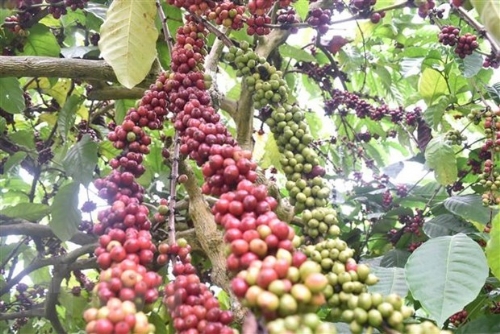Shrimp Exports Forecast at US$4 Billion in 2018
Monday, July 30, 2018 14:43

The European Union (EU) is the most prominent shrimp importer of Vietnam. The country's shrimp shipments to the EU were worth US$405.6 million in the first six months of 2018, up 38 per cent year on year.
According to the Vietnam Association of Seafood Exporters and Producers (VASEP), Vietnam's shrimp exports valued US$893 million in the second quarter of 2018, down 4.9 per cent, on fluctuations in domestic and international shrimp prices. However, driven by a 20 per cent growth in the first quarter, Vietnam's shrimp exports still rose 5.1 per cent on year to US$1.6 billion in the first six months of this year. Given that import demands start to grow in the second half of this year and domestic and international shrimp prices are stable again, VASEP forecast that Vietnam's shrimp exports will reach US$4 billion this year.
After robust growth in the first quarter, shrimp shipments slightly decreased in the second quarter. In April, May and June, shrimp exports brought home US$275.2 million, US$309.9 million, and US$308.2 million, down 0.4 per cent, 5.7 per cent, and 7.8 per cent from a year earlier.
Price decreases and higher shrimp output in other countries were attributed to the second-quarter export decline. Thus, importers asked us to lower prices, which sank the export value of Vietnam. In addition, import demands by major markets were also weak on high stockpiles.
Most shrimp producers lowered prices in the second quarter. The price of white shrimp in Vietnam dropped 20-30 per cent from April to mid-June. Shrimp prices in Thailand and India plunged sharply during April and May. The price of white-legged shrimp in China fell to a five-year low of US$ 4.30 per kilo in the first week of July.
White-legged shrimps account for 67.2 per cent of Vietnam's shrimp exports in the first six months of this year, followed by prawns with 23.7 per cent of the market share and sea shrimps with 9.1 per cent.
In the first half, white-legged shrimp exports climbed 14 per cent while black tiger shrimp exports sank 6 per cent from the same period of 2017. The value of processed white-legged shrimps and live/fresh/frozen white-legged shrimp looked up 21 per cent and 9 per cent, respectively, while processed and live/fresh/frozen tiger shrimps tumbled 18 per cent and 5 per cent, respectively.
Export growth slowed down in the first half of this year as shipments to mainstream markets plunged, for example, Japan (down 11.2 per cent), China (down 13.2 per cent) and the United States (down 7.5 per cent). The strong export growth of 38 per cent to the EU played a crucial role in driving up the six-month export growth. Shrimp exports to South Korea and Australia jumped 24 per cent and 16 per cent, respectively.
Without a doubt, the EU is the most prominent shrimp importer of Vietnam in 2017 and the first six months of 2018. Shrimp shipments to the EU grew in all months. In the first half of this year, Vietnamese shrimp exports to the EU reached US$405.6 million, representing a year on year growth of 38 per cent. Exports to three major markets (the Netherlands, the United Kingdom and Germany) grew at a double-digit pace of 74 per cent, 23 per cent and 53 per cent.
Vietnam’s shrimp exports to the EU in the reviewed period maintained a high growth because of tax incentives, India (Vietnam's key competitor in this market) facing difficulty in sending shrimps to the EU, and promising opportunities for Vietnam's exports from the impending EU-Vietnam Free Trade Agreement (EVFTA).
Shrimp exports to the US fell 7.5 per cent year on year to US$255.7 million in the first half of this year. In 2017, shipments to this market dipped 7 per cent from a year earlier notwithstanding growth elsewhere. Antidumping tax hike was partly attributed to the decline here.
The tariff was raised to as high as 25.39 per cent at the 12th Period of Review (POR12) from February 1, 2016 to January 31, 2017. This rate was very much higher than the previous ones. Although lawyers found miscalculation by the Department of Commerce (DOC) and this preliminary result was for reference only, this decision more or less worried both buyers and sellers.
In addition, at the end of April 2018, shrimp was officially added by the US National Oceanic and Atmospheric Administration (NOAA) to the Seafood Import Monitoring Programme (SIMP). Accordingly, by December 31, 2018, shrimp importers must fully comply with SIMP requirements.
Nevertheless, Vietnamese shrimps still have much room to grow in this market because its market share is just 10 per cent here (about 60,000 tonnes) while its export capacity can reach 150,000 tonnes.
Statistics showed that US shrimp imports tended to rise after the first six months since 2015. For that reason, the second half of the year will be a good time for exporters to boost shipments to this market.
PV
Other news
- Vietnam remains world's second biggest coffee exporter(9/16/2022 10:49:37 AM)
- 2022 trade surplus estimated at US$1 billion(8/31/2022 2:45:08 PM)
- Shrimp exports to US, China endures double-digit decrease in July(8/31/2022 2:39:52 PM)
- Global inflation skyrockets as domestic exports start to feel pinch(8/30/2022 4:08:37 PM)
- Exports to the Netherlands edge up 31.6% over seven months(8/30/2022 4:05:24 PM)
- Bangladesh to purchase huge amount of rice from Vietnam(8/30/2022 4:03:18 PM)
- Shrimp exports to US, China endures double-digit decrease in July(8/30/2022 4:01:31 PM)
- Textile - garment exports to grow further this year(8/30/2022 3:48:20 PM)
- Aquatic exports to Belgium surge 74.32% during seven-month period(8/24/2022 3:27:21 PM)
- US, China become largest consumers of Vietnamese pangasius(8/24/2022 3:22:24 PM)






